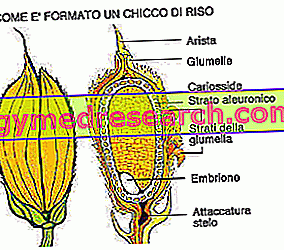Production
From Beans to Rice Oil
The rice oil is extracted from the germ and from the films that externally wrap the rice grain (called glume and glumelle or in the whole chaff or husk).
The rice oil is then produced starting from the residues of the hull, from which the brown rice is obtained by removing the husk and the bleaching, by which the embryo and the outer parts of the grain are removed (pericarp, sperm and aleuronic layer).

Due to the high oil content, the husk is also sold in pellets as an alternative fuel; it has a mealy and greyish appearance, it is soft, light, with a strong tendency to agglomerate and go rancid.
For the production of rice oil, the husk, together with the embryo, is first dried and then subjected to mechanical pressing, followed by a grinding process by filtration, centrifugation and possible chemical processes. The residue of this processing undergoes a further oily extraction with the use of chemical solvents (then removed by evaporation), before being conveyed to the feed industry.

Nutritional properties
Rice oil is particularly appreciated in the food and cosmetic fields.
|
In the table to the side we can see how the rice oil is an oil with a high content of oleic acid, monounsaturated typical of olive oil, and linoleic acid, polyunsaturated typical of vegetable oils. Phospholipids include phosphatidylcholine, phosphatidylinositol and phosphatidylethanolamine, but are largely removed during the grinding process.
The main nutritional virtues of rice oil depend on the unsaponifiable fraction, where high concentrations of vitamin E are found in the ratio 1: 1 between tocotrienols and tocopherols. Peculiar is the presence of gamma oryzanol, consisting of a mixture of ferulic acid esters with plant sterols and triterpene alcohols; analogous substances are now used in supplements intended for the reduction of plasma cholesterol levels under the generic name of "plant sterols" or "phytosterols". Therefore, thanks also to the abundant presence of tocopherols and the richness in monounsaturated fatty acids (oleic acid) and polyunsaturated fatty acids (linoleic acid), antioxidant, anti-inflammatory, cholesterol-lowering, hypotriglyceridemizing and preventive properties of cardiovascular diseases are ascribed to rice oil. It should however be pointed out that many of these properties are considerably reduced by the processes of refining and extraction with solvents, so it is a good rule to prefer virgin rice oils, cold pressed and stored in dark glass bottles. For the same reason, rice oil should only be used to season raw, as its beneficial properties are lost through heat; given the high smoke point and oxidation resistance, we are still talking about an oil that is particularly suitable for frying.
Cosmetic Uses
See also: rice oil in cosmetics
Rice oil is also appreciated by the cosmetic industry for its emollient, anti-inflammatory, moisturizing and UV-protective power.
Rice oil tocopherols, second only to palm oil concentration, are widely used as anti-aging functional substances, intended for the treatment and prevention of premature skin aging.
For all these properties, rice oil is widely used in dermatology, cosmetics and solar preparations.



